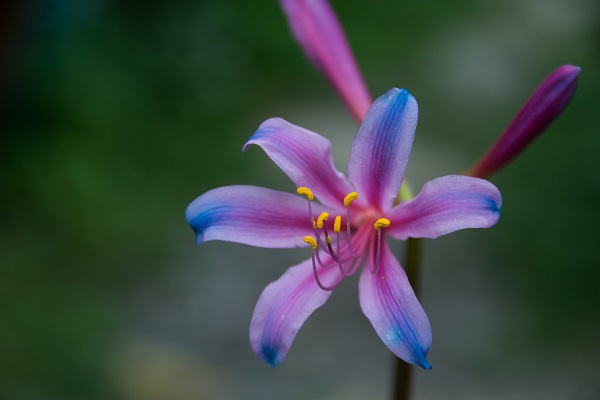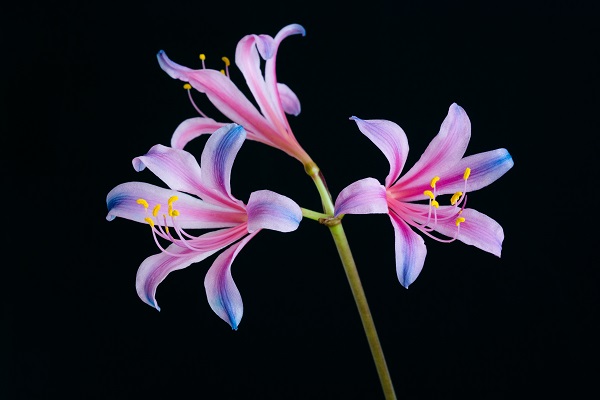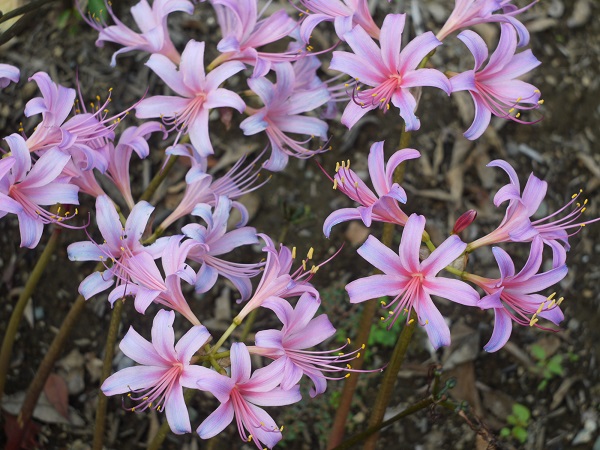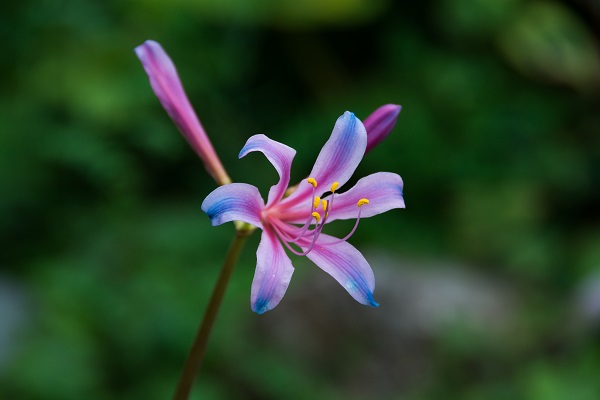

The Lycoris sprengeri is often called the "Electric Blue Spider Lily." Depending on where you plant this bulb and the temperatures the color of the bloom will change. The blooms vary from pink to blue to almost purple on the edges. These lovely blooms are fascinating and unique. They work best in zones 5b-8a.

How they bloom: Lycoris sprengeri "Electric Blue Spider Lily" bulbs bloom differently than most flowers. Now is a perfect time to plant these bulbs. These bulbs need 1-2 years after they are planted before presenting blooms. Your bulbs are developing a strong root system right now to support future foliage and eventually blooms. You should see the foliage this February - May, but don't be concerned if you don't. Most people still expect to see something growing during the summer months. You won't see anything. These bulbs are dormant in the summer. After 1-2 years, the flowers suddenly appear with the first later summer and early fall rains. One day there is nothing growing and then suddenly you have a surprise, a fully blooming flower! This bulb acts very similarly to red spider lilies, yellow spider lilies, and schoolhouse lilies. Simply put, they bloom in the fall and then have foliage for the winter.

Foliage: Let's talk foliage for a moment. The "Electric Blue Spider Lily's" strap-shaped long foliage will look great by itself in the spring or mixed in with spring blooms. We know that we all want to see the beautiful unusual blooms in the late summer, but the foliage is very important. The foliage is what allows the bulb to grow and multiply. Many people get very concerned if they don't see the bloom the first year that they plant it and believe that maybe the bulb isn't any good. A good rule for perennial bulbs....if the bulb is firm when you plant it, it is healthy and will eventually come up. The foliage is what you watch for since the bulbs aren't going to bloom for 1-2 years. The foliage will grow during the spring months, February - May, so be sure to plant the bulbs where they will receive at least 6+ hours of winter sun. Even if the foliage gets hit by a winter cold snap, it will have taken in nutrients for months! Always allow the foliage to die down naturally and don't cut it off. If you cut it, you are killing the bulb. Once the foliage is completely dead which is usually around the middle of May, this area can be mowed. Remember, it takes a lot of energy for the bulb to push that bloom up out of the ground and open wide. The more time the bulbs can take in nutrients, the more energy they will have for that fall bloom.

Just a thought...if it looks like you are going to have a cold snap and want to protect your foliage, you might consider covering it with a bucket and then removing the bucket once the daytime temperatures warm up.

Blooms: When talking about color, these unique blooms have no equal. The petals will vary in color slightly depending on the heat. The blooms tend to be more of a deep pink when the temperatures are very hot in the upper 90s. The more blue and purple color occur when the temperatures for late August tend to run cooler in the upper 70s. The blooms will appear late August or early September on a naked stalk like the other Lycoris. In late summer, each bulb sends up an 12-16 inch stem that holds several blooms. It may take 1-2 years before the blooms appear, but the show it produces in late summer is unparrelled. Once established in your garden they are there for a lifetime! These blooms need water to bloom. They respond to the late summer rains well, but if there is a hard drought, be sure to begin watering the area around the beginning of July to help the bulbs have enough energy to bloom. A naked stalk will rise quickly and a few days later the landscape will burst with bright blooms.

Sun Requirements: The single most important thing about landscaping with Lycoris is the sun. They need at least 6+hours of WINTER sun. That means about 6-8 hours of sunlight during the winter months - they do great with full winter sun. Because they are dormant during the summer, the amount of summer sun doesn't matter; however, these Lycoris will keep some of their color better if they get some afternoon shade during their blooming time in August/September.
The Lycoris all have the same requirements of the sun. If you look at the photo above of the Lycoris squamigera "Naked Lady" blooms, you will see that they are in the shade of the trees. You can be sure that most, if not all, of those trees, will lose their leaves in the winter when the greenery needs sunlight. Lycoris put on their foliage during the winter (February - May) and that is when it takes in the nutrients it needs to produce the blooms in August/September. The winter foliage soaks up sun energy during winter as it prepares for summer dormancy. The foliage normally completely dies down around May.

Plant: Don't plant the bulb too deep. You will plant the bulbs 2-3 times deep the height of the bulb (so if your bulb is 1" tall, then you will plant it 2-3 inches deep). Because they bloom on a naked stalk, they look better when planted in groups. You can plant the bulbs close together (2-4 inches apart) to make the blooms look more natural or spread the bulbs out and allow 6-8 inches in between each bulb. The area will look sparse the first couple of years that the blooms come up, but the bulbs will multiply and fill in several years after that.
Lycoris bulbs really do well in any type of soil except full clay. They thrive in soil that has plenty of organic material mixed in but they do not require fertilizer. Newly planted bulbs would actually be harmed by exposure to fertilizer, so if you are going to apply nutrients, limit the application to established plants when the plants are producing their green leafy foliage during the winter. After planting the bulbs, water the soil thoroughly. Damp soil is ok, as long as the bulbs are in a spot where they will receive plenty of winter sun and the foliage is allowed to die down naturally in the spring. Standing water is not good. Once the summer season starts these bulbs will do best in soil that dries out a bit, as this facilitates its entry into the dormant stage when the leaves die back. This period is followed by its blooming season when it will reward daily watering with long-lasting blooms. Too much moisture in the soil will lead to the bulbs rotting.

Bulbs to use with Lycoris: There are an assortment of perennial flower bulbs that go well with Lycoris blooms. When the bloom appears in late August or early September, it will look great with rain lilies and other spider lilies. The foliage makes a great backdrop for spring bloomers like Narcissus Jonquils, campernelles, twin sisters, and snowflakes.
The Lycoris sprengeri is often called the "Electric Blue Spider Lily." Depending on where you plant this bulb and the temperatures the color of the bloom will change. The blooms vary from pink to blue to almost purple on the edges. These lovely blooms are fascinating and unique. They work best in zones 5b-8a.

How they bloom: Lycoris sprengeri "Electric Blue Spider Lily" bulbs bloom differently than most flowers. Now is a perfect time to plant these bulbs. These bulbs need 1-2 years after they are planted before presenting blooms. Your bulbs are developing a strong root system right now to support future foliage and eventually blooms. You should see the foliage this February - May, but don't be concerned if you don't. Most people still expect to see something growing during the summer months. You won't see anything. These bulbs are dormant in the summer. After 1-2 years, the flowers suddenly appear with the first later summer and early fall rains. One day there is nothing growing and then suddenly you have a surprise, a fully blooming flower! This bulb acts very similarly to red spider lilies, yellow spider lilies, and schoolhouse lilies. Simply put, they bloom in the fall and then have foliage for the winter.

Foliage: Let's talk foliage for a moment. The "Electric Blue Spider Lily's" strap-shaped long foliage will look great by itself in the spring or mixed in with spring blooms. We know that we all want to see the beautiful unusual blooms in the late summer, but the foliage is very important. The foliage is what allows the bulb to grow and multiply. Many people get very concerned if they don't see the bloom the first year that they plant it and believe that maybe the bulb isn't any good. A good rule for perennial bulbs....if the bulb is firm when you plant it, it is healthy and will eventually come up. The foliage is what you watch for since the bulbs aren't going to bloom for 1-2 years. The foliage will grow during the spring months, February - May, so be sure to plant the bulbs where they will receive at least 6+ hours of winter sun. Even if the foliage gets hit by a winter cold snap, it will have taken in nutrients for months! Always allow the foliage to die down naturally and don't cut it off. If you cut it, you are killing the bulb. Once the foliage is completely dead which is usually around the middle of May, this area can be mowed. Remember, it takes a lot of energy for the bulb to push that bloom up out of the ground and open wide. The more time the bulbs can take in nutrients, the more energy they will have for that fall bloom.

Just a thought...if it looks like you are going to have a cold snap and want to protect your foliage, you might consider covering it with a bucket and then removing the bucket once the daytime temperatures warm up.

Blooms: When talking about color, these unique blooms have no equal. The petals will vary in color slightly depending on the heat. The blooms tend to be more of a deep pink when the temperatures are very hot in the upper 90s. The more blue and purple color occur when the temperatures for late August tend to run cooler in the upper 70s. The blooms will appear late August or early September on a naked stalk like the other Lycoris. In late summer, each bulb sends up an 12-16 inch stem that holds several blooms. It may take 1-2 years before the blooms appear, but the show it produces in late summer is unparrelled. Once established in your garden they are there for a lifetime! These blooms need water to bloom. They respond to the late summer rains well, but if there is a hard drought, be sure to begin watering the area around the beginning of July to help the bulbs have enough energy to bloom. A naked stalk will rise quickly and a few days later the landscape will burst with bright blooms.

Sun Requirements: The single most important thing about landscaping with Lycoris is the sun. They need at least 6+hours of WINTER sun. That means about 6-8 hours of sunlight during the winter months - they do great with full winter sun. Because they are dormant during the summer, the amount of summer sun doesn't matter; however, these Lycoris will keep some of their color better if they get some afternoon shade during their blooming time in August/September.
The Lycoris all have the same requirements of the sun. If you look at the photo above of the Lycoris squamigera "Naked Lady" blooms, you will see that they are in the shade of the trees. You can be sure that most, if not all, of those trees, will lose their leaves in the winter when the greenery needs sunlight. Lycoris put on their foliage during the winter (February - May) and that is when it takes in the nutrients it needs to produce the blooms in August/September. The winter foliage soaks up sun energy during winter as it prepares for summer dormancy. The foliage normally completely dies down around May.

Plant: Don't plant the bulb too deep. You will plant the bulbs 2-3 times deep the height of the bulb (so if your bulb is 1" tall, then you will plant it 2-3 inches deep). Because they bloom on a naked stalk, they look better when planted in groups. You can plant the bulbs close together (2-4 inches apart) to make the blooms look more natural or spread the bulbs out and allow 6-8 inches in between each bulb. The area will look sparse the first couple of years that the blooms come up, but the bulbs will multiply and fill in several years after that.
Lycoris bulbs really do well in any type of soil except full clay. They thrive in soil that has plenty of organic material mixed in but they do not require fertilizer. Newly planted bulbs would actually be harmed by exposure to fertilizer, so if you are going to apply nutrients, limit the application to established plants when the plants are producing their green leafy foliage during the winter. After planting the bulbs, water the soil thoroughly. Damp soil is ok, as long as the bulbs are in a spot where they will receive plenty of winter sun and the foliage is allowed to die down naturally in the spring. Standing water is not good. Once the summer season starts these bulbs will do best in soil that dries out a bit, as this facilitates its entry into the dormant stage when the leaves die back. This period is followed by its blooming season when it will reward daily watering with long-lasting blooms. Too much moisture in the soil will lead to the bulbs rotting.

Bulbs to use with Lycoris: There are an assortment of perennial flower bulbs that go well with Lycoris blooms. When the bloom appears in late August or early September, it will look great with rain lilies and other spider lilies. The foliage makes a great backdrop for spring bloomers like Narcissus Jonquils, campernelles, twin sisters, and snowflakes.